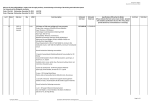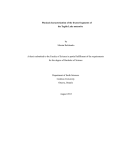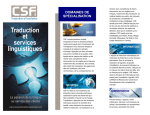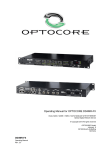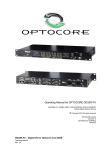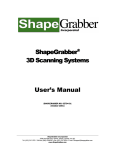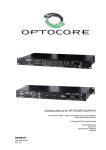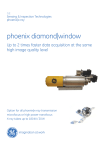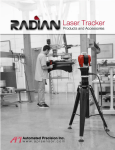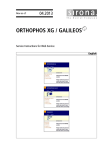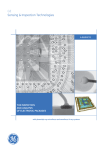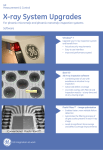Download GE phoenix nanotom s Operating Manual
Transcript
18th World Conference on Nondestructive Testing, 16-20 April 2012, Durban, South Africa Fully-Automated 3D Metrology and Defect Analysis with High-Resolution 300 kV Microfocus Computed Tomography Oliver Brunke1 1 Product Manager for 3D Metrology and Failure Analysis using Computer Tomography, GE Sensing & Inspection Technologies GmbH, 31515 Wunstorf, Germany; Phone: +49 5031 172 142, E-mail: [email protected], www.ge-mcs.com/phoenix Abstract With industrial X-ray computed tomography (CT), even low-contrast defects in cast parts, such as cracks, pores and blowholes, can be localized and measured in three dimensions. Analysis of the defects can be performed using either multi-positional 2D cross-section planes or the 3D volume view. Additionally, 3D metrology with CT becomes more and more an effective tool for many tasks in production process monitoring such as the manufacture of plastics, metal castings and precision components like injection nozzles. Particularly complex part geometries with inaccessible or hidden features can be measured with CT in many cases faster than with conventional Coordinate Measuring Machines (CMMs). This paper shows failure analysis and metrology tasks automatically performed on a new GE CT system optimized for stable and reproducible CT scans and equipped with a new unipolar 300 kV microfocus X-ray tube, new CT software for fully automated data acquisition, volume processing and 3D evaluation capability. Keywords: 3D Metrology, automated Computed Tomography, CT, µCT, CMM 1. Introduction Complete 3D mapping means that CT can also be used for the non-destructive 3D measurement of cast parts that cannot be inspected using conventional coordinate measuring machines due to their complex internal geometry. Therefore, CT has numerous practical uses in addition to non-destructive quality control; for instance, it can be used for optimizing and reducing the time required for development and initial sampling processes, comparing components with the target CAD model or reverse engineering in which 3D component data is used to construct a three-dimensional CAD model (fig 1). Fully automated scanning and analysis processes mean that the creation of first-article inspection reports, even for complex components, is possible in less than one hour. Fig. 1: Reverse engineering, automatic pore analysis and 3D metrology of a scanned automotive control arm 2. Advanced CT Technology The new phoenix v|tome|x m of GE Inspection Technologies is the industry’s first compact 300 kV CT system for 3D metrology and failure analysis with less than 1µm detail detectability, suitable for 500 x 600 mm samples with a field-of-view up to 300 mm diameter and 400 mm in height and up to 50 kg in weight. The system offers excellent magnification and resolution for high-absorbing metal samples. With up to 500 W the tube comes with also enough power to examine a broad range of parts, including light metal castings in just a few minutes. For particularly high-resolution scans, an optional 180 kV high-power nanofocus tube can be selected at the touch of a button. Its versatility ensures the new system a wide spectrum of applications in materials science, industrial failure analysis, process control and 3D metrology in industrial sectors ranging from castings and electronics to plastics, geology and aerospace, including turbine blade inspection. Fig. 2: Comparison of a turbine blade scanned using a conventional 225 kV tube (left) and GE’s 300 kV (xy sections): The 300 kV microfocus X-ray tube enables more precise scans with significantly reduced artifacts ensuring more precise wall thickness measurements (right). 3. Non-Destructive 3D Defect Analysis Over the past few years, industrial computed tomography has made great advances in increasingly higher resolution and ever greater reconstruction speeds for 3D volume data. Thanks to graphics processor unit (GPU)-based image reconstruction, CT results are now available within minutes. Full three-dimensional scanning of samples and the possibility of creating cross-sections from any angle opens up new analysis-related and time-saving potential for foundry-based quality controls. With automatic porosity analysis (fig. 3), the size of the inclusions can be shown on a table or marked in different colours on the component itself, thus giving an indication as to the quality of the cast process, or component stability. It can also be used to verify correct assembly or to determine the position of cast components following an inconclusive 2D X-ray inspection. Fig. 3: Automatic porosity analysis of an automotive casting. The distribution of differently sized pores within the entire cast part can be shown in different colours. 4. High-Resolution CT-Based 3D Metrology Due to the large number of internal contours in cast parts made from plastic or light alloys, the use of conventional measurement methods to inspect such parts is often not possible in a nondestructive way and takes a considerable amount of time. The fact that CT offers extremely precise and complete 3D representation of objects opens up its field of application, meaning that it is also suitable for coordinate measuring. This is because, in contrast to conventional tactile or optical coordinate measuring systems, CT measuring systems are also able to completely capture the hidden contours of specimens, such as cavities and undercuts. In addition, a CT scan of a specimen results in a very high number of measurement points, typically in the order of magnitude of 105 to 106, which can then be used (through the application of statistical methods) to achieve a measurement resolution that is typically significantly below 1/10 of the voxel size (voxel = volumetric pixel); which, depending on the object size, is within the micrometer range. Fig. 4 shows, by way of an example, a target/actual comparison of the variances between a specimen and the CAD model. The swiftly generated results from these measurements can be used as a basis for correcting the manufacturing process in a timely manner and optimizing series production. Fig. 4: Using false colour image display to compare the measurement data and CAD model allows a qualitative judgment to be made quickly regarding the production quality of the casting. The precision of the measured raw data (CT projection data) determines the accuracy of all subsequent evaluations. In addition to a stable system structure that is optimized for the specific application at hand, data processing is the key to successful CT-based measurement. For optimal measurement results, therefore, the reconstruction algorithm used to calculate the volume data has to take into account and correct the unavoidable physical effects of CT scanning, such as 'beam hardening'. The phoenix|x-ray CT product range of GE Inspection Technologies features a variety of software modules for optimized volume data reconstruction. It also offers a comprehensive range of software packages for surface-data analysis, including element modelling, DIN/ISO-compliant geometric dimensioning and tolerancing calculation (GD&T), and even the fully-automated generation of initial sample inspection reports. The measurement data generated using dedicated, optimized surface extraction is traced back to normal standards using DKD-certified (German metrology accreditation body) specimens. 5. The CT-based 3D measurement process chain: 5.1 Data acquisition The actual physical measurement is taken by scanning a series of 2D X-ray projection images. To do this, the specimen is positioned on a granite-based precision manipulation system and, during the measurement, is completely rotated through 360° on a precision turntable. A 2D projection image is typically taken every <0.5°. The quality of the raw data, and naturally the accuracy of all subsequent evaluations, is significantly influenced by the sharpness of the X-ray images, which is heavily dependent on the quality of the x-ray source and detector in addition to the precision and stability of the manipulation device. Therefore, the more effectively the CT measurement system performs this first step, the more precisely the measurement task can be performed. 5.2 Volume reconstruction The volumetric data set for the specimen is generated from the raw data using a numeric reconstruction method filtered back-projection. For optimum measurement results, the reconstruction algorithm should take into account and correct the physical effects, such as beam hardening or thermal expansion, during the raw data capture in step 1. 5.3 Surface data generation For the subsequent processing of the measurement results, the surface is extracted from the volume data as a generic ASCII point cloud or STL surface for import into 3D inspection software, such as the Polyworks Inspector™ (InnovMetric Software Inc., Canada). 5.4 Evaluation and analysis (virtual coordinate measuring machine) After importing the surface data from the specimen into the 3D analysis software, the additional measuring steps can be performed (fig. 5). These steps include a target/actual comparison between the surface data and the CAD model with a variance analysis or measurements using ruled geometries. Fig. 5: Nom. /act. comparison and evaluation of three dimensional parameters on a scanned cylinder head. 6. Fully Automated Data Acquisition and Volume Processing With GE’s advanced phoenix datos|x CT software, the entire CT chain described above can be fully automated. The software offers fully automated data acquisition and volume processing, so that high resolution, precision metrology and failure analysis tasks can now be performed with minimal operator training within a dramatically reduced required operator time. The click & measure|CT functionality minimizes the operator time and influence, while highly increasing the repeatability and reproducibility of CT results. Once the appropriate setup for a part is programmed, the whole scan and reconstruction process as well as 3D failure analysis or 3D metrology evaluations like generation of first article inspection reports can be executed automatically. The click & measure|CT functionality of the new software allows users to display and analyze the 3D results on the screen in just three steps: fix the work piece, start the scan, check the results. Therefore, the skill requirements for the operator are dramatically reduced, while the required operator time to run a CT analysis is decreased by a factor up to 5 compared to the previous software version. This saves costs and highly increases the repeatability and reproducibility of CT results by minimizing the operator influence. Once the appropriate setup is programmed, the whole scan and reconstruction process including volume optimization features or surface extraction runs without any operator interaction. Furthermore, 3D failure analysis or metrology tasks performed with third party programs can be executed automatically. Since the entire process of the CT data acquisition over the volume reconstruction to implementation of the measurement runs completely automatically, it is now possible to conduct the first article inspection of a complex component in less than 60 minutes. 7. Substantiation of CT Measurement Accuracy To substantiate the measurement accuracy of the phoenix|x-ray computed tomographs of GE Measurement & Control, and therefore their suitability for use as 3D coordinate measuring machines, a valve block made from aircraft aluminium with an edge length of 130 mm was subjected to a CT scan at Continental AG in Frankfurt followed by a reference measurement using high-precision tactile 3D coordinate measurement technology. GE’s phoenix v|tome|x computed tomograph was used for the CT scan and a Hexagon Metrology Leitz 3D PMM 8.6.6 coordinate measuring machine for the reference measurement. Table 1 contains extracts from the specimen inspection report and demonstrates the excellent concordance between both the KMM and CT measurement methods: The proven diameter and length variance is ≤6 µm. Parameter Target CAD Tolerance Actual CT Actual CMM CT/CMM variance Ø Z 1 [mm] 28.000 0.050 28.035 28.034 0.001 Distance A 1 [mm] 70.500 0.100 70.442 70.447 -0.005 Table 1: Excellent correspondence between the measurement data from the 3D coordinate measuring machine and high-resolution computed tomography 8. Conclusion: How Advances in CT Systems are Benefiting Foundries A new tomograph from the GE’s phoenix|x-ray business which has recently been placed on the market and which features a revolutionary unipolar 300 kV/500 W microfocus x-ray tube is enabling CT analyses of difficult-to-penetrate components at particularly high levels of magnification (fig. 5). It is the first time that a resolution of up to 1 µm has been achieved with a 300 kV X-ray tube. The CT system also uses a new high dynamic temperature-stabilized digital detector with even higher contrast resolution. As a result of recent hardware and software developments, the phoenix v|tome|x m (fig. 6) offers effective CT results in a very short time. The user-friendly and highly efficient phoenix|x-ray CT software datos|x 2.0 includes a wide variety of modules for optimizing CT results for superior precision and quality. Additionally, the new bhc|module corrects beam hardening automatically. This compensation for undesirable artifacts significantly increases the precision of pore analyses or surface extraction for subsequent dimensional measurements. The click & measure|CT functionality offers a significant reduction of the required operator time. Hardware innovations are also ensuring more precise measurement results. The phoenix v|tome|x m can be used for full, high-resolution 3D scanning of samples, making it ideal for non-destructive quality control in foundries. The system also has a special metrology package that contains everything needed for precise and intuitive 3D metrology, from calibration instruments to a high accuracy direct measuring system. In many cases, Ct offers considerable advantages compared to conventional coordinate measuring machines, especially, when measuring complex parts or hidden or difficult-to-access surfaces, such as high density of measurement points and fast capturing even of the complete internal geometry of the work piece. Fully automated click & measure|CT allows the entire CT process to be fully automated minimizing the operator time and influence while highly increasing the repeatability and reproducibility of the CT results. Fig. 6: Due to its unipolar microfocus X-ray tube, the phoenix|x-ray v|tome|x m CT system is particularly suited to high-resolution scans of highly radiation-absorbent components at particularly high levels of magnification.






